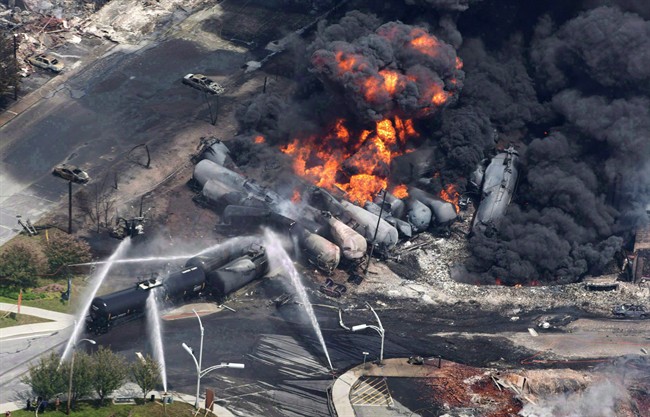On March 1, a rail car full of asphalt rolled away from the Co-op Refinery toward downtown Regina – uncontrolled – for about four kilometres. It crossed seven streets before coming to a stop.

READ MORE: Runaway rail car full of asphalt rolls toward downtown Regina from Co-op refinery
Then a few weeks later on March 27, an empty Canadian Pacific Railway hopper car rolled through a railyard in Saskatoon and across two public level crossings in the city before coming to a stop.
READ MORE: Another runaway railcar in Saskatchewan
No injuries were reported and both incidents are still under investigation by the Transportation Safety Board (TSB).
According to data collected by the TSB, from 2004 to 2015, there was an average of 13 runaway rail stock reported across Canada.
“Sometimes, by coincidence, you have a frequency at one location, but we are currently investigating a couple of other runaways, one in Ontario and one in Québec, so it’s not just Saskatchewan,” Rob Johnston, manager for the Central Region for the rail and pipeline investigation branch for the TSB, said.
- Train goes up in flames while rolling through London, Ont. Here’s what we know
- Budget 2024 failed to spark ‘political reboot’ for Liberals, polling suggests
- Wrong remains sent to ‘exhausted’ Canadian family after death on Cuba vacation
- Peel police chief met Sri Lankan officer a court says ‘participated’ in torture
Johnston said runaway rolling stock incidents are reportable to the TSB and can happen for various reasons, such as handbrakes not being applied properly.
“These are things we keep track of in our statistics but runaway rolling stock are reportable to the TSB,” Johston said.
“That’s an incident that does get reported to us on a regular basis.”
Stephanie Lines, director of operations management for the Transport Canada rail safety board, said lessons were learned after the Lac-Mégantic rail disaster on July 6, 2013. A runaway freight train pulling 72 crude-oil laden DOT-111 railcars derailed and exploded.
READ MORE: Ottawa to retire DOT-111 rail tanker cars ahead of schedule
The disaster killed 47 people and flattened the town’s downtown core.
“The government has taken a number of measures to improve railway safety and rail securement is certainly one of them,” Lines said.
Companies are now required to refer to a chart when securing equipment. The chart dictates the number of handbrakes that need to be applied depending on where the train is parked and the weight of the train.
Employees must also communicate to each other about how the equipment is secured and there must also be a secondary means of securement.
Tanis Peterson, director of regulatory affairs with the Railway Association of Canada, said the requirements are complex, but now include a secondary line of defence, like air brakes.
“So when leaving cars unattended, or a train unattended, instead of just having one means, which is you know a principle when obviously it’s handbrake, but there are again many different scenarios,” Peterson said.
“Instead of just one means of defence, it’s a proven means and it worked well, in case there is an error, we have a secondary means as a backup.”
Johnston said if a runaway car or train is a factor in a collision, it will be noted in the accident’s report.
A search through rail reports shows seven incidents across Canada since 2004 that are classified as accidental and include a runaway element, including the Lac-Mégantic train derailment.
Cando Contracting was fined $109,000 by Transport Canada for violating the Railway Safety Act and the Canadian Rail Operating Rules following the runaway incident in Regina.
“Those crossings were protected with warning systems, but still it was nighttime, it was one car, it was dark, it might not have been easily seen by somebody at a crossing,” Lines said.
“They would have seen the crossing activation, but it’s possible that they didn’t see the car.
“It also was dangerous for other railway operating employees who would not have known that that car was coming and again it was dark and not attached to a locomotive that was lit.”
While there are fines, Lines said it is also up to the company to ensure the rules are enforced.
“It is their responsibility to ensure that their employees are fully knowledgeable about the rules that apply to them in their operation and that they have ongoing assessments of their capability and their knowledge in ensuring that they are completely aware of what the company’s procedures are,” Lines said.
Ottawa is currently in a transition period, Lions said, as it moves from old regulations to the new ones under the Safety Management System regulations.
Among other changes, the department has made a commitment that over the next three to five years, the government will audit all federally regulated companies for compliance.
Transport Canada also has a risk-based inspection program, with 33,000 oversight activities a year. The government organization is responsible for federally regulated railways and has agreements with some provinces to oversee some provincially regulated railways.
According to a Transport Canada report, there are more than 40,000 kilometres of federally regulated railway in Canada, and that seems to account for most of Canada’s train tracks. But the provinces are in charge of regulating the rest of Canada’s rail system – another 5,000 km or so. Peterson said moving forward, it’s always interesting to watch the way technology evolves for safety improvements.
For example, Peterson points to an emergency switch with rollaway protection that if the train starts moving, depending on the circumstances would use the air brake to stop the train. It became a requirement in 2015.
“Some companies started installing the rollaway protection prior to the rule but at least now we’ve put it in the rule, because again, we’ve got to keep track of the technology coming out and integrating it,” Peterson said.



Comments